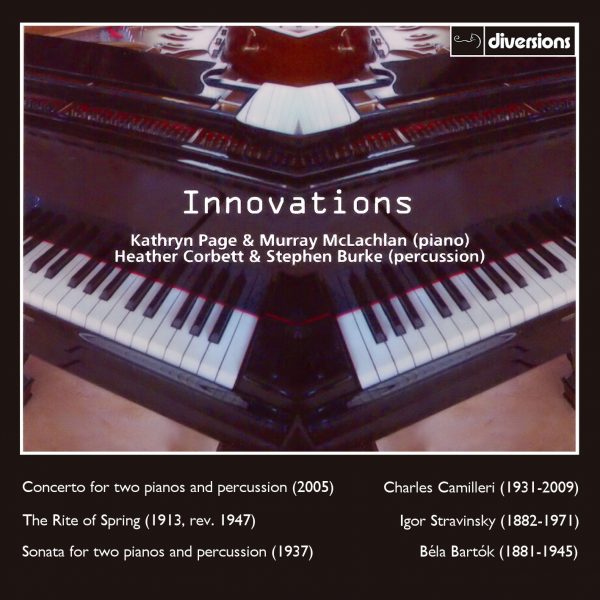Fanfare
The idea of coupling Bartók’s Sonata for Two Pianos and Percussion with Camilleri’s concerto for that combination, and then using those as the outer layers of a Stravinsky sandwich, is nothing less than inspired. Back in 2008 (Fanfare 32:2), 1 enjoyed a disc of Charles Camilleri’s orchestral music, again on Divine Art; the piece here, written in 2005, is more forbidding than anything on that earlier disc. It ambitiously also sets out to treat tonality, atonality, and polytonality on an even play¬ing field: “equal partners,” as the composer puts it. Camilleri uses timpani, side drum, bongos, con¬gas, glockenspiel, vibraphone (motor off), xylophone, and cymbals as his percussion to create a sometimes primal sound. Like Bartók’s, Camilleri’s slow movement (this one marked “Libero”) is tremendously atmospheric. The performance itself is magnificently concentrated and impactful.
The sandwich filling, like the Bartók, encounters huge competition. Yet Page and McLachlan’s Rite stands high for its timbral variety and its intelligence in realizing Stravinsky’s strata. There is a huge range of dynamics here, too. Pedaling has been meticulously thought through, and the final “Sacrificial Dance” really does have a sense of the dance about it. If Hamelin and Andsnes on Hyperion are more primal, and with Bavouzet/Guy on Chandos occupying a sort of mid-point between the Hyperion and the Divine Art, one can only celebrate the diversity currently on offer. As an aside, the present recording would be fabulous for any student of the score in terms of elucidating compositional process.
My preferred modem recording of the Bartók Sonata for Two Pianos and Percussion remains Cedric Tiberghien, François-Frederic Guy, Colin Currie, and Sam Walton on Hyperion, a 2016 recording on an all-Bartók disc, both on performance and in recording terms. However, there is no doubting the technical prowess in the McLachlan/Page performance, particularly in the climactic moments of the first movement and in the more animated passages of the second movement.
The recording (made at Whiteley Hall, Chetham’s School of Music, Manchester, UK) is un-fortunately a little boomy and unfocused; the final movement of the Camilleri suffers somewhat as a result. But the playing and programming are fantastic, and the playing time is more than generous.
@divineartrecordingsgroup
A First Inversion Company
Registered Office:
176-178 Pontefract Road, Cudworth, Barnsley S72 8BE
+44 1226 596703
Fort Worth, TX 76110
+1.682.233.4978











![Listen to the full suite of Marcel Dupré’s Variations Sur un Noël, Op. 20 from Alexander Ffinch’s #Expectations release today! listn.fm/expectations [in bio]](https://scontent-dfw5-1.cdninstagram.com/v/t51.71878-15/588904367_2327488161082898_8709236950834211856_n.jpg?stp=dst-jpg_e35_tt6&_nc_cat=105&ccb=7-5&_nc_sid=18de74&efg=eyJlZmdfdGFnIjoiQ0xJUFMuYmVzdF9pbWFnZV91cmxnZW4uQzMifQ%3D%3D&_nc_ohc=H3rHeRayPTgQ7kNvwEufg3v&_nc_oc=AdlSqLDwkEBsOv3UChLaOUY8R0HdARgfntIahcFZHteYmZmOy3mO5KYWtBjQgIOtvIw&_nc_zt=23&_nc_ht=scontent-dfw5-1.cdninstagram.com&edm=ANo9K5cEAAAA&_nc_gid=AQ-2GFTWOARycTNqTZeEtw&oh=00_AfmOhAIT5Ybu42LniewuaHe13ABBpnHE72i6ZG9iLw4oLQ&oe=69595DAA)
